
Presidential Procession to the Fairgrounds
This is Part 2 of our series “Opening Day of the World’s Fair,” which explores the events of May 1, 1893, at the World’s Columbian Exposition in Chicago. The full series can be found here.
Finely decorated with flags and bunting

The Auditorium Building, where the Duke of Vergua stayed. [Image from the Rijksmueum, Amsterdam.]
By 8 o’clock, members of the citizen’s committee, representing the State Department and appointed to host the Duke and Duchess, were on hand at the Auditorium. Bertha Palmer arrived and was ushered up to the duke’s apartments. Such large crowds had formed outside and along Congress and Michigan Avenue that police had a difficult time keeping the sidewalk clear in front of the Auditorium. Soon, the ducal party emerged from the building.
Wearing gorgeous uniforms of their country
Don Cristobol Colon de la Cerda, the Admiral Duke of Veragua, was dressed in his gorgeous Spanish admiral uniform covered with ribbons. He and the other male members of the party were decorated in every available spot with gold lace. They wore hats bearing feathers while swords hung at their sides.
The Duchess of Veragua wore a pink silk dress adorned with small red flowers, a dark green mantle, a rich train of old Spanish lace, and a black bonnet. Her dazzling jewel bore the emblem of the order of the Ladies of Honor of Spain: two-inch high letters “C” in diamonds and “R” in rubies topped with a crown and resting on a red ribbon. Below it, the Duchess wore the emblem of the Daughters of Mary Washington, which she had received during her earlier visit to New York.

The Duke and Duchess of Veragua. [Image from Dedicatory and Opening Ceremonies of the World’s Columbian Exposition (Stone, Kastler & Painter, 1893.]
The other distinguished members of the ducal party were: Cristóbal Colón de la Cerda y Aguilara, son and heir of the Duke and Duchess; Hon. Maria del Pilar Colon y Aguilera, daughter of the Duke and Duchess; Fernando Colon, the Marquis de Barboles, brother of the Duke; Pedro (Peter) Colon y Bertodano, youngest son of Marquis de Barboles and nephew of the Duke; Carlos (Charles) de Aguilera, nephew of the Duchess; Rodrigo de Saaverdra, the Marquis de Villalobar, nephew of the Duke.

The Ducal Party (top, L to R ) Cristóbal (Christopher) Colón, Pilar Colón, the Marquis de Barboles; (bottom, L to R) Pedro (Peter) Colon, Carlos (Charles) de Aguilera, and the Marquis de Villalobar. [Images from Dedicatory and Opening Ceremonies of the World’s Columbian Exposition (Stone, Kastler & Painter, 1893.]
Chicagoans lined the sidewalks along the nearly two-mile route down Michigan Avenue to the Lexington Hotel. Here the ducal party from Spain joined that of the President of the United States.
The Lexington

The Lexington Hotel, where President Cleveland stayed. [Image from The Inland Architect.]
Located at the corner of Michigan Avenue and 22nd Street, the Lexington sat at the boundary between the tony Prairie Avenue residential neighborhood and the rather seedy Levee District. (Decades later, the Lexington became famous as the home of notorious Chicago gangster Al Capone, who operated out of the hotel from 1928 until his arrest in 1931; the building was demolished in 1995.)
Several members of President Cleveland’s cabinet also stayed at the Lexington. They were Secretary of State Walter Q. Gresham, Secretary of Treasury John G. Carlisle, Secretary of the Interior Hoke Smith, Secretary of the Navy Hilary A. Herbert, and Secretary of Agriculture Julius Sterling Morton. (Not present for the opening of the World’s Fair were Secretary of War Daniel S. Lamont, Attorney General Richard Olney, and Postmaster General Wilson S. Bissell.)

President Cleveland and his cabinet members who attended the Columbian Exposition Opening Ceremony. [Image from the Review of Reviews April 1893.]
Bugle boy

“Departure from the Lexington” from the Chicago Inter Ocean, May 2, 1893.
As early as 7:30 a.m. on Opening Day of the Exposition, crowds began forming in the streets around the Lexington Hotel. By 8, there were some 500 onlookers. By 9, some ten thousand spectators attempted to crowd into a space that could hardly accommodate half that number.
While waiting for the president to emerge, the crowd found entertainment in the form of a small boy sitting in a bay window of the fifth floor of the hotel playing his cornet. Quite adept at cavalry signals, the youngster created confusion among the official procession below. With precision and perseverance, the little fellow blew calls⎯mount! dismount! wheel!⎯that perplexed the horses and their men. He interspersed his signals with verses of “America (My Country ’Tis of Thee),” “Suwannee River” and other popular tunes. As the boy began his rendition of “Ta-ra-ra Boom-de-aye,” Major T. A. Baldwin of the 7th Cavalry sent an orderly up to end the concert. The bugle boy was pulled from the window struggling and crying.
Other officials arrive
Vice President Adlai Stevenson, Illinois Governor John Altgeld and his staff, and former President of the Columbian Exposition Lyman Gage arrived by carriage from the Palmer House hotel at around 8:30 am. When Stevenson walked into the Lexington lobby unattended, no one in the throng outside seemed to recognize their home-state former congressman.
When carriages bringing Chicago Mayor Carter Harrison and other city officials arrived at the hotel, the crowd cheered so enthusiastically that every window overlooking the block suddenly filled with onlookers. As the mayor attempted to enter the hotel lobby, however, a police lieutenant commanded him to “stand back!” The mayor dismissively retorted “Not this time!” and made his way in. This was only the first in a string of obstacles blocking Mayor Harrison from reaching the presidential party on Opening Day.
“Sit in the middle, Grover!”

“The President Leaving the Lexington” from the Chicago Herald, May 2, 1893.
At 9 o’clock the call of “Attention!” rang out in Major Baldwin’s gruff voice, and his signal trumpeter repeated the word in sharp blasts. In a moment, man and horse were immovable in a long line stretching on the west side of the avenue from 21st to 22nd Streets. President Cleveland emerged from the main entrance of the hotel, accompanied by Harlow Higinbotham, president of the exposition, and T. W. Palmer, president of the national commission.
Wearing a black overcoat and silk hat, President Cleveland bowed to the large crowd assembled. Mighty shouts went up from the multitude as the president stepped quickly forward to one the finest private carriages. He took the seat to the right while bowing to the enthusiastic crowd, as if to leave room for somebody by his side. “Sit in the middle, Grover!” shouted someone in the throng. The president laughingly complied, while Mr. Higinbotham and Mr. Palmer took their seats opposite him. While apparently in great good humor, the president seemed to be anxious to avoid public notice rather than court it.
The presidential carriage, owned by Chicago businessman Cyrus H. McCormick, looked magnificent. Driving a team of chestnut sorrels for leaders and light bays for wheelers, the coachman sported a pink and yellow boutonniere and terra cotta gloves to his dark brown livery. The gold-plated harness carried the elaborate McCormick monogram on blinds and cruppers. The two ducal carriages, both owned by Potter Palmer, were of lesser pretensions.

“The President Starting for Fair Grounds” from The Chicago Daily Tribune , May 2, 1893.
The procession order

“The Chicago Hussars on Service” from the Chicago Inter Ocean, May 2, 1893.
Escorted by a platoon of park police mounted, the 7th cavalry, and the Chicago Hussars, the full procession, fifty carriages in number, included:
- Director-General George R. Davis and Director of Works Daniel Burnham (7th carriage);
- President Cleveland, President T. W. Palmer of the national commission, and President of the World’s Columbian Exposition, Harlow Higinbotham (8th carriage);
- Vice-president of the United States Adlai Stevenson, escorted by Lyman J. Gage and W. T. Baker, ex-presidents of the World’s Columbian Exposition (9th carriage);
- the Duke of Veragua, Vice-President of the World’s Columbian Exposition Ferd W. Peck, and Vice-President of the National Commission Thomas A. Waller (19th carriage);
- the Duchess of Veragua with Mrs. Potter Palmer (20th carriage);
- Governor Altgeld (25th carriage); Mayor Harrison (26th carriage)
Other carriages carried distinguished guests and Chicago citizens, members of the national commission and the local board, the reception committee of the council, aldermen and other city officials, officials and members of the council from Philadelphia, county commissioners and county officials.
Libel on the president
The procession presented a handsome appearance as it moved at a rapid pace down Michigan Avenue for the five-mile journey the fairgrounds in Jackson Park. The gray-coated park policemen on their stalwart horses looked massive and imposing, while Chief of Police Robert W. McClaughry and his staff wore brilliant new uniforms.
Crowds on the sidewalk repeatedly cheered the president as he passed. At least one irrepressible person on hand offered irreverent remarks, saying: “There he goes; looks as though he had been up all night.” This was a libel on the president, thought one reporter within earshot who testified in his paper that Mr. Cleveland in fact had retired early on the previous evening and seemed particularly good tempered during the drive to the fair.
One of the finest thoroughfares in the world

“Driving on the Grand Boulevard” Underwood and Underwood stereoscope card.
The threat of rain dampened somewhat the amount of decorations along Michigan Avenue and Grand Boulevard, but there were notable exceptions. The procession passed Ferd Peck’s mansion at 1626 Michigan Ave., which was profusely and tastefully decorated with flags and bunting. At 29th Street, the pretty decorations of Mr. Higinbotham’s mansion at 2934 Michigan Avenue attracted the attention of President Cleveland, who frequently noticed different residences on the route that were beautifully adorned.
The parade turned east on 35th Street, where a cheering crowd occupied not only the sidewalks but the streets. At the corner of Indiana Avenue, a relic from Dedication Day the previous October remained: a rickety structure of an old grand arch that people had climbed onto to get a better view of the passing dignitaries.
On reaching Grand Boulevard* the procession turned south, and the president had the pleasure of travelling along one of the finest thoroughfares in the world. Bunting and flags decorated the way, and the gay uniforms of the soldiers showed to great advantage when thrown into relief by the green grass of the boulevard. When they reached 39th Street (now E. Pershing Road), Inspector Koch retired from the procession, his jurisdiction ceasing at that street, and the police arrangements went into Inspector Hunt’s hands.
* Grand Boulevard is now known as Martin Luther King Drive and runs along the western edge of Washington Park, which is connected to the Midway Plaisance and western entrance to the fairgrounds.

“Passing of President Cleveland” from the Chicago Inter-Ocean.
At 43rd and 47th Streets, great crowds were assembled. Frequent cheers greeted the president, and he responded by raising his hat. At 51st Street the procession entered the Washington Park, rode around the meadow and toward the western entrance of the Midway Plaisance. Crowds filled every inch of space between here and the entrance to the fairgrounds at Cottage Grove Avenue, despite the roadway being ankle deep in mud. Police and the Columbian Guard kept the entrance to the Midway clear. Although no rain had fallen during the march from the Lexington, the clouds had begun to gather again and all were afraid that there would be another downpour.

The Procession to Jackson Park [Image from The Graphic History of the Fair (Graphic Co., 1894).]
Muddy march down the Midway

“On Way to Fair Grounds” from the Chicago Eagle, May 2, 1893.
The crowd at the western gate of the fairgrounds, an estimated thirty thousand people, was something fearful, yet orderly. With great difficulty the troopers and police forced open a passage for the presidential procession. Louder and louder grew the cheering, and it was evident that the supreme moment was at hand when the President of the United States would first officially enter the precincts of the World’s Columbian Exposition. The front line of the parade entered the west end of the Midway at 10:30 am to the sounds of horns and drums.
Perhaps responding to the tremendous shout announcing the president’s arrival, the sun came out from behind a bank of clouds and with a joyous smile welcomed all with a happy omen.
Citizens of the various international villages of the Midway came to the central street to greet the President Cleveland. A Turkish band played an air of welcome while standing in a line in front of the Moorish palace. The people of the Street in Cairo made numerous and profound salutes as the party passed. The Javanese cheered the soldiers as they passed their village. Trained lions from Hagenbeck’s Zoo roared in honor. Girls watched the parade from the windows of the Irish Village, as did the “forty beauties” from forty different countries in the Congress of Beauty exhibit.
As his carriage turned from the Midway Plaisance into Jackson Park in front of the Woman’s Building at 11 o’clock, the president cast one last look back longingly over his shoulder.

“Parade Passing East on Midway Plaisance on Opening Day” [Image from Glimpses of the World’s Fair Through a Camera. Laird & Lee, 1893.]
Entering the Administration Building

“The President Leaving his Carriage” on the west side of the Administration Building from The Chicago Inter Ocean, May 2, 1893.
With the blare of a bugle, the troops swung into line, extending the full length of the Administration Building’s west side. Their capes were thrown back, showing the bright yellow of the facings. The horses danced and pranced and pawed the sand, and curved their graceful necks in pride. The riders drew their sabers for a salute.
When the President stepped from his carriage, the sun sparkled in a thousand splinters from the shining steels. The chief magistrate bared his head as cheer followed cheer. Looking toward the bright sky, he smiled. This pleased the crowd, and the host laughed and applauded again. Some people stood in the mud. Others perched on the frame of new buildings or in the nooks and numberless gables and balconies of the surrounding palaces.
By this time President Higinbotham had reached the side of his two companions in honor, carrying in both hands great clusters of roses. The president’s cabinet came, with but little enthusiasm, and the Duke of Veragua did not get a response from the crowd. He looked with interested at the line of troops and acknowledged their salute by lifting his hat. The Duke walked briskly into the building, turning once to wonder at the almost endless lines of people. The other guests from Spain received about the same applause.
Mayor Harrison behind bars

Chicago Mayor Carter Harrison. [Image from the Library of Congress.]
Harrison and his councilmen entered the elevator.
“Let her go,” instructed the mayor to the lift operator. The car rose a few feet and then stuck, with a jerk and groan.
“Go on up,” called the mayor.
“Can’t,” replied the elevator boy. “She’s stuck.”
“Cut the rope,” directed Alderman Madden.
For ten minutes they hung there. Carter beat against the iron bars of his cage in vain, succeeding only in seriously ruffling his eagle-feathered temper. Just then Director-general Davis hove in sight.
“Hey! I say, Davis; let me out,” yelled Mr. Harrison.
“How long you in for?” asked the Director-General laconically.
“Let me out, I say.”
“Haven’t got the key,” replied Davis with a smile.
By that time the janitors had got the elevator going again, and the party returned to the first floor, in time for the Opening Ceremony to begin outside the eastern entrance of the building.
This would not be the last insult to Mayor Harrison today.
SOURCES
(See our note about sources here.)
“And All Was Peace” Chicago Inter Ocean May 2, 1893, p. 4.
“Banquet of Nations” Chicago Inter Ocean May 2, 1893, p. 1.
“Behind the Bars” Chicago Inter Ocean May 2, 1893, p. 2.
“Epoch in History” Chicago Herald May 2, 1893, p. 1.
“How it was Opened” Chicago Inter Ocean May 2, 1893, p. 1.
“Opened to the World” Chicago Eagle May 5, 1893, p. 6.
“Opening Ceremonies World’s Columbian Exposition” in Columbian Exposition Dedication Ceremonies Memorial. Metropolitan Art Engraving & Publishing Company, 1893, pp. 212−224.
“How They Went” Chicago Inter Ocean May 2, 1893, p. 2.
“Start Made from the Lexington” Chicago Daily Tribune May 2, 1893, p. 4.
“Viewing the Parade” Chicago Daily Tribune May 2, 1893, p. 4.

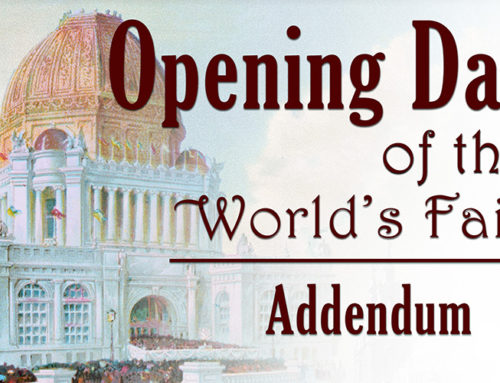
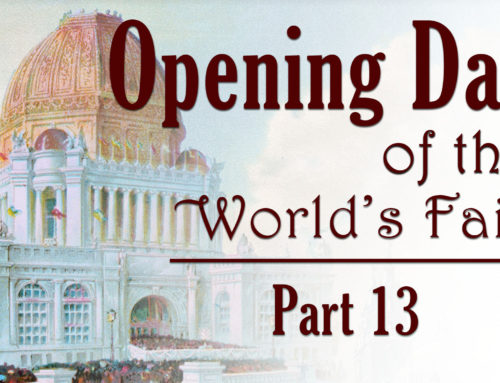
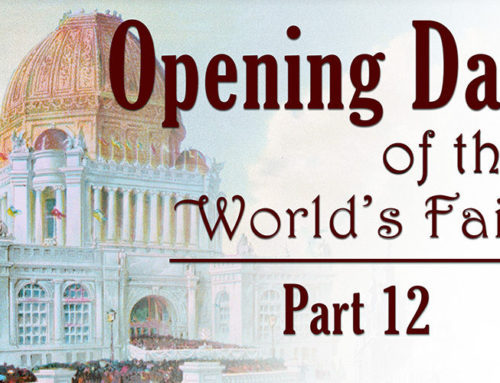
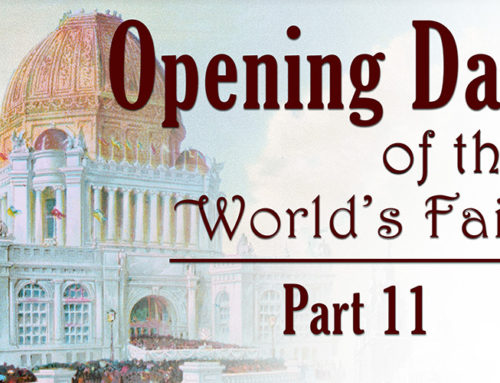
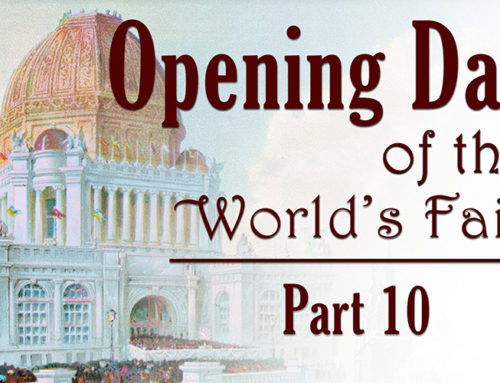
Leave A Comment